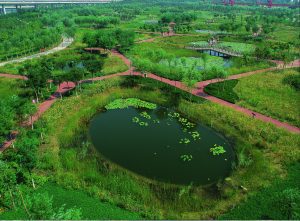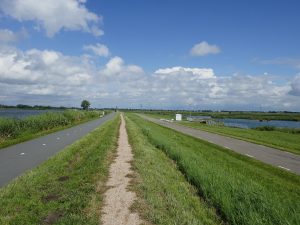Crippling heat has been blasting the world this summer and the impacts of climate change are front of mind for many. Beyond the immediate risk to human health, these higher-than-average temperatures have lasting consequences – as the mercury rises and ice sheets melt, sea level rise is an increasing concern. Rising sea water already affects millions around the world, and without curbing emissions, it’s predicted that more than 800 million people, living in 570 cities around the world, could be at risk by the end of the century.

These are sobering statistics, but the efforts of coastal cities and countries to build resiliency in the face of sea level rise is reason for hope. Innovative solutions are popping up around the world that highlight new and creative ways to protect people, property and wildlife from the threat of rising seas.
4 Places with Innovative Sea Level Rise Solutions
Traditionally, solutions to sea level rise have fallen into three main categories – building infrastructure (like levees, sea walls, and pumps), promoting natural solutions (like planting mangrove forests, or building up sand dunes) and relocation (moving at-risk cities to safer inland areas). In this blog, we’ll highlight a few projects around the world that take these traditional solutions to new heights.
1. The Maldives’ Floating City
The Maldives, a group of islands in the Indian Ocean, is one of the most vulnerable nations to rising seas. In 2022, the government of The Maldives paired with a Dutch property development firm to develop a fully floating city that can rise with the waters. Designed to resemble brain corral, the city will eventually hold 20,000 people and include restaurants, shops, schools, and housing. People will get around using interconnected canals or can ride electric bikes, scooters, or buggies on sandy paths. Importantly, the environmental impacts were rigorously studied before the city’s development and artificial coral banks are attached to the underside of the structure to promote the growth of sea coral.
The concept of floating construction is not new, and there are a handful of similar projects around the world, like OceanIx in South Korea. If momentum continues, and especially if there are marked improvements in affordability and scalability, floating architecture could become a viable solution for vulnerable communities in the years ahead.
2. China’s “Sponge” Initiative
About 45% of China’s population resides in coastal cities, and China’s sea levels have risen by an average of 3.5 mm per year since 1980. This, combined with rapid development and the increase in non-permeable concrete surfaces, has put Chinese coastal communities at particular risk. China’s “sponge city” initiative, launched in 2015, can help to ease this increasing challenge. The idea behind “sponge cities” is to replace concrete with permeable natural surfaces that can absorb water like a sponge so that it doesn’t run-off and cause flooding. Sponge cities do things like remove concrete to plant natural grasses, restore wetlands, create rain gardens, green roofs and overflow ponds, and rebuild roads and footpaths with permeable concrete.

Retaining water at the source: One of the early sponge city projects designed by Turenscape to retain urban stormwater, remediate soil and restore native habitat, and creating a public space.
China’s “sponge city” project began with a pilot program of 30 cities, many of them coastal. Analysis after the initial pilot showed an overall positive impact, however implementation on a larger scale has been slow around the country. And keeping up with the rising severity of storms has proven challenging, with flooding still occurring in many of the pilot cities. So while sponge cities may not be a silver bullet solution, they can make cities more resilient while also restoring wild spaces and helping residents connect with nature. For coastal cities that are at particularly high risk, spongy initiatives are certainly a worthy cause.
3. Rotterdam’s Strategic Overflow
The Netherlands has long been at the forefront of innovation related to sea level rise. And for good reason – much of the nation lies below sea level and it is slowly sinking. In the climate adaptation world, Rotterdam might be best known for its gigantic flood gate, the Maeslant storm surge barrier (the largest moving object in the world!). While the gate is certainly a technological marvel, the idea of flood gates to fight sea level rise is fairly well-known. It is the holistic approach to flood management that stands out as innovative in Rotterdam, and The Netherlands in general.
Rather than fighting the ocean to keep water out, they are essentially inviting water in and making it part of the community fabric. The idea is part of a nation-wide project called Room for the River, where lakes, parks, and other public spaces are designed to double as giant reservoirs when flood waters rise. A prime example is an extensive rowing course built in Rotterdam, which hosted the World Rowing Championships and is part of 22 acres of reclaimed fields and canals. This idea of guiding floodwaters into designated spaces has been studied in coastal California as well. Research has shown that seawalls constructed in one part of the San Francisco Bay contribute to flooding in neighboring communities, whereas coordinating efforts to guide overflow into specific natural spaces can reduce flooding for the entire shoreline.

Drainage construction for water storage in the Eendragtspolder on the Rottemeren, Zuidplas, South Holland.
4. Senegal’s Stakes with Palm Fronds
Sea level rise takes a toll on coastal communities, causing erosion and damaging both property and wildlife habitats. Restoration projects like protecting dunes, maintaining mangrove forests, and restoring wetlands can have a big positive impact. For several years now on Diogue Island in Senegal, the community has been achieving success in coastal restoration with very limited resources. The project involves driving clusters of wooden stakes into the shoreline, and lining them with palm fronds. The palm leaves catch sand, which overtime builds the beach back up to fight off erosion. Since the start of the initiative, shoreline has been reclaimed and the project has expanded. As of 2022, nearly 100 feet had been added, with plans to continue growing. This community-based project is a successful model for other at-risk coastal communities that may have limited resources for larger, more expensive infrastructure.
Resiliency for All
In the fight against rising seas there is no doubt that wealthy countries, and those with more stable populations, are better positioned to implement mitigation strategies. As we face this global challenge, it will be critical for the world to come together to share ideas, technology, and funding, and ultimately, to scale innovative and effective solutions that can be accessible to all. There is a lot of work to be done, but these four places provide hope for the power of human ingenuity and resolve for a sustainable world.
Image credits: Graph (Sea Levels Continue to Rise by Statista); Sponge city (Mydogistiaotiaohu, CC BY-SA 4.0, via Wikimedia Commons); Drainage construction in Holland (Wilrooij, CC BY-SA 4.0, via Wikimedia Commons)




